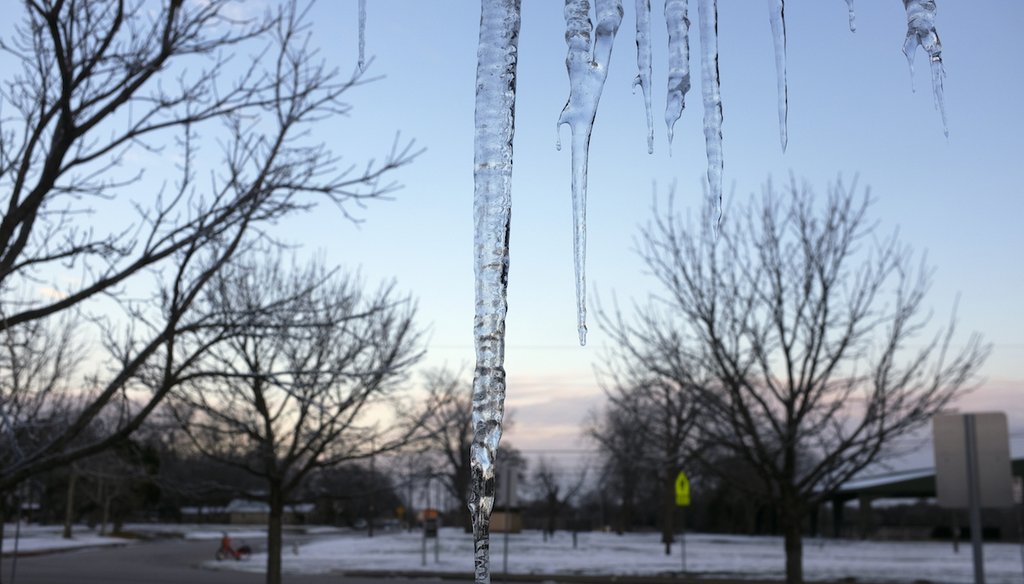Stand up for the facts!
Our only agenda is to publish the truth so you can be an informed participant in democracy.
We need your help.
I would like to contribute

Icicles hang from an awning in a snow covered park on Feb. 18, 2021, in Austin, Texas. (AP)
Estimated winter heating costs at highest level in over a decade
If Your Time is short
-
Expected energy costs for winter heating, based on federal data outlooks, reached its highest level in 10 to 15 years.
- The statistic comes from an analysis by a policy organization, the National Energy Assistance Directors Association, that says it represents state directors in the Low Income Home Energy Assistance Program.
U.S. Rep. Morgan Luttrell, R-Texas, brought attention to energy costs in a recent tweet about broad energy indicators.
"Energy costs are the highest in 15 years," the newly elected Houston area congressman wrote Jan. 10.
We already fact-checked another claim he made in the tweet about the U.S. Strategic Petroleum Reserve being at its lowest level in nearly 40 years that he included in that same tweet. We rated that True.
Now we’re examining his second claim: Are energy costs at a 15-year high?
Luttrell’s statistic pertains to winter heating costs
Luttrell's office pointed to a November CNN article about the Biden administration distributing $4.5 billion to alleviate Americans’ high energy bills through the Low Income Home Energy Assistance Program. The program distributes federal funding to states for home heating and cooling costs.
Sign up for PolitiFact texts
Mark Wolfe, executive director of the National Energy Assistance Directors Association, told CNN the cost of home energy this winter is at its highest level in more than 15 years. The association's website says it represents state directors for the federal energy assistance program, and the association advocates for households needing LIHEAP assistance.
Wolfe told PolitiFact Texas the numbers used in the association’s analysis are from the U.S. Energy Information Administration (EIA) Winter Fuels Outlook. The EIA issues this annual outlook on fuels — natural gas, heating oil, electricity and propane — used during winter in U.S. homes for heating and other uses. Data is grouped by fuel type.
The EIA estimated in October the average household spending on natural gas would jump 28% compared to the previous winter. Heating oil, electricity and propane would jump 27%, 10% and 5% respectively.
Although Luttrell referred to energy costs, Wolfe’s statement pertains specifically to home heating costs.
EIA considers a wide variety of factors in its analysis. For example, natural gas prices increased because of a strong demand for exporting, according to the October outlook. And consumers generally bear the brunt of wholesale price changes in petroleum-based fuels, such as heating oil and propane.
"They do estimates by fuel type. They don’t do a national average. So, we do a weighted (average) based on the prices," Wolfe said.
A November news release by the association said home heating costs will reach their highest level in more than 10 years. The association’s release was based on the October EIA estimates.
Wolfe said prices are volatile now, but have been trending high.
"Not all fuels are at a 15-year high," Wolfe said. "It depends on what you’re looking at. But the average is at a 15 year-high."
A look at federal energy data
EIA data calculates the average seasonal household expenditure nationally for natural gas, electricity and heating oil. (Propane — used by a small share of U.S. households as a primary heating fuel — is not included in the data). Households are grouped by their primary heating fuel. EIA provided historical expenditure data from winter 2007-08 and onward to PolitiFact Texas.
The average U.S. household costs for electricity, heating oil and natural gas are forecast to be higher in the 2022-23 winter compared with the one in 2007-08, about 15 years ago. Prices, however, fluctuated within that time span.
The $1,371 average cost for electricity in the updated February forecast exceeds the winter 2007-08 level of $939. The $809 average cost for natural gas this winter exceeds the 2007-2008 level of $743.
Featured Fact-check
For heating oil, this winter’s average household cost is forecast at $2,231, compared with $1,617 in winter 2007-08.
In the 2013-14 winter, however, the average $2,122 cost for heating came close to the current forecast, data shows.
Average 2022-23 energy costs forecast for each fuel type are the highest in the past 15 years. Luttrell’s statistic checks out.
The average cost estimates the EIA provided for the 2022-23 winter are updated forecasts it made in February. Luttrell’s claim relied on cost forecasts made in October, which were even higher for natural gas and heating oil (and about the same for electricity). Luttrell’s statistic still holds true with the data available at that time.
Of note, EIA does not isolate heating costs from other energy usage expenses. So, for example, if a household’s primary heating fuel is electricity, and electricity also powers appliances and lighting, then the heating expenditure for electricity is lumped in with the other electricity-related expenditures.
Although the data can reflect some other household energy costs, EIA forecasts are made to understand household heating costs, not overall energy costs.
Our ruling
Luttrell said, "Energy costs are the highest in 15 years."
Luttrell’s statistic — which he pulled from an article citing the National Energy Assistance Directors Association — holds true with the data available and analyzed at the time.
EIA data provided to PolitiFact show that average household heating costs are higher now than they were 15 years ago, and these expenditures are higher than any other year during that time span.
Luttrell’s statistic, however, didn’t specify that his statistic pertained to predicted household heating costs, so the figure could have been understood to encompass other costs, such as gasoline or household energy costs.
We rate this Mostly True.
Our Sources
Tweet by Rep. Morgan Luttrell (@repluttrell_tx8), Jan. 10, 2023
Email from Communications Director Cally Perkins at the Office of Rep. Morgan Luttrell, R-Texas, Jan. 10, 2023
Tami Luhby, CNN, "Biden administration distributes billions to lower heating costs as energy prices soar," Nov. 2, 2022
U.S. Bureau of Labor Statistics, "CPI for all Urban Consumers (CPI-U): Household energy in U.S. city average, all urban consumers, seasonally adjusted," data extracted Jan. 11, 2023
Phone interview with Mark Wolfe, executive director of The National Energy Assistance Directors’ Association, Jan. 18, 2023
Email from Mark Wolfe at The National Energy Assistance Directors' Association, Jan. 11, 2023
C-SPAN Washington Journal, "Mark Wolfe on winter energy costs and assistance," Sept. 27, 2022
Phone call with energy consultant Robert McCollough at McCullough Research, Jan. 12, 2023
Emails from Chris Higginbotham and Morgan Butterfield at the Energy Information Administration, Jan. 11, Jan. 19, Jan. 25, and Jan. 26, 2023
Phone call with Chris Higginbotham at the Energy Information Administration, Jan. 25, 2023
Emailed historical Table WF01. Average Consumer Prices and Expenditures for Heating Fuels During the Winter, sent on Jan. 26, 2023
Energy Information Administration, "Winter Fuels Outlook," October 2022
Energy Information Administration, "Table WF01. Average consumer prices and expenditures for heating fuels during the winter," Short-Term Energy Outlook-February 2023
Browse the Truth-O-Meter
More by Nusaiba Mizan
Estimated winter heating costs at highest level in over a decade
Support independent fact-checking.
Become a member!
In a world of wild talk and fake news, help us stand up for the facts.









































